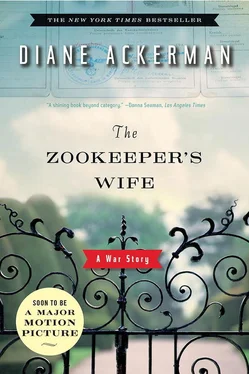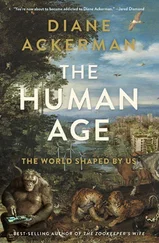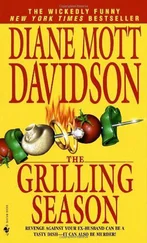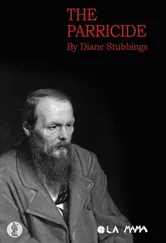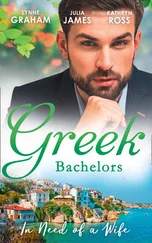Josef Mengele grew up in a family of Bavarian industrialists, and declared his religion as Catholic on official forms (instead of “believer in God,” as Nazism preferred). Genetic abnormalities fascinated him, and “Dr. Auschwitz,” as he came to be known, had an ample pool of children on whom to do experiments which the Frankfurt court would later denounce as “hideous crimes” performed “willfully and with bloodlust,” which often included vivisection or murder. “He was brutal but in a gentlemanly, depraved way,” one prisoner reported, and others described him as “very playful,” “a Rudolph Valentino type,” always smelling of eau de cologne. (Quoted in Robert Jay Lifton, The Nazi Doctors: Medical Killing and the Psychology of Genocide [New York: Basic Books, 1986], p. 343.) “In selecting for death or in killing people himself, the essence of Mengele was flamboyant detachment—one might say disinterestedness—and efficiency,” Lifton concludes (p. 347).
As new prisoners arrived, guards marched up and down the lines calling out “ Zwillinge, zwillinge! ” as they hunted twins for Mengele to tamper with in gruesome ways. Changing eye color became his favorite line of research, and on one wall of his office, he displayed an array of surgically removed eyes pinned up like a collection of moths.
Konrad Lorenz quoted in Ute Deichmann, Biologists Under Hitler , trans. Thomas Dunlap (Cambridge, Mass.: Harvard University Press, 1996), p. 187.
Konrad Lorenz, “Durch Domestikation verursachte Störungen artewigen Verhaltens,” Zeitschrift für angewandte Psychologie und Charaklerunde , vol. 59 (1940), p. 69.
As part of Hitler’s inner circle, he quickly rose to “air minister,” as well as “Master of the German Hunt” and “Master of German Forests.” More than just an avid huntsman—he once had a stag from his estate flown to him in France so that he could track and shoot it—Göring identified hunting with life at his boyhood castle, and dreamt of returning Germany to its lost greatness (“Our time will come again!” he would proclaim). Weekends he spent in the forests, and seizing any excuse to combine politics and hunting, he hosted haute cuisine shooting parties. Hitler didn’t hunt, though he often wore hunter’s garb, especially at his lodge in the Alps, as if at any moment he might release a falcon or leap into the saddle and chase a candelabra-horned stag.
Fascinated by boar hunting, Göring prized a custom-made fifty-inch boar spear with a leaf-shaped blade of blue steel, a dark mahogany grip, and a steel shaft with two hollow pleated spheres that rattled to scare his prey from the underbrush.
Göring took dozens of hunting trips with friends, foreign dignitaries, and members of the German high command from the mid-1930s to late 1943; and documents show that even in January and February of 1943, while Germany was losing on the Russian front, Göring was at his castle, hunting Rominten wild boar and Prussian royal stags. (During this same period he also introduced ballroom dancing lessons for Luftwaffe officers.)
It continues to this day, though it’s now issued in Poland. No bloodline information is kept on the wild bison, which rangers simply keep an eye on and count.
For good discussions of the motif, see Piotr Daszkiewicz and Jean Aikhenbaum, Aurochs, le retour… d’une supercherie nazie (Paris: HSTES, 1999), and Frank Fox, “Zagrożone gatunki: Żydzi i żubry” (Endangered Species: Jews and Buffalo), Zwoje, January 29, 2002.
Heck, Animals , p. 89.
This curse of closely knit species also applies to our dairy cows, now almost clones of one another; an illness that kills one can kill all.
“The Matrilineal Ancestry of Ashkenazi Jewry: Portrait of a Recent Founder Event”: Doron M. Behar, Ene Metspalu, Toomas Kivisild, Alessandro Achilli, Yarin Hadid, Shay Tzur, Luisa Pereira, Antonio Amorim, Lluís Quintana-Murci, Kari Majamaa, Corinna Herrnstadt, Neil Howell, Oleg Balanovsky, Ildus Kutuev, Andrey Pshenichnov, David Gurwitz, Batsheva Bonne-Tamir, Antonio Torroni, Richard Villems, and Karl Skorecki. American Journal of Human Genetics , March 2006.
That person didn’t live all alone on the planet; it’s simply that no one else’s offspring survived.
Pierre Lecomte du Noüy, La dignite humaine (1944).
Norman Davies, Rising ’44: The Battle for Warsaw (London: Pan Books, 2003), p. 183.
So many excellent books have been written about daily life in the Ghetto, the Jew roundups, and the horrors of the death camps, that I don’t linger on them. A particularly vivid account of the Uprising that comes to mind is A Fragment of the Diary of the Rubbish Men , by Leon Najberg, who fought with armed stragglers among the ruins until the end of September.
From a transcript read at the Nuremberg trials, reported in “The Fallen Eagles,” Time , December 3, 1945.
Out of its prewar population of 36 million, Poland lost 22 percent, more than any other country in Europe. After the war, Yad Vashem in Jerusalem, the State Tribunal of Israel, detailed some of Christian Poland’s ordeal, and how, in addition to the 6 million Jews killed, 3 million Catholics died, “but what is even worse, it lost especially its educated classes, youth and any elements which could in the future oppose one or the other of the two totalitarian regimes…. According to the German plan, Poles were to become a people without education, slaves for the German overlords.”
Michał Grynberg, ed., Words to Outlive Us: Eyewitness Accounts from the Warsaw Ghetto , trans. Philip Boehm (London: Granta Books, 2003), p. 46.
At one point Himmler invited Werner Heisenberg to establish an institute to study icy stars because, according to the cosmology of Welteislehre, based on the observations of the Austrian Hanns Hörbiger (author of Glazial-Kosmogonie [1913]), most bodies in the solar system, our moon included, are giant icebergs. A refrigeration engineer, Hörbiger was persuaded by how shiny the moon and planets appeared at night, and also by Norse mythology, in which the solar system emerged from a gigantic collision between fire and ice, with ice winning. Hörbiger died in 1931, but his theory became popular among Nazi scientists and Hitler swore that the unusually cold winters in the 1940s proved the reality of Welteislehre. Nicholas Goodrick-Clarke’s The Occult Roots of Nazism explores the influence of such magnetic lunatics as Karl Maria Wiligut, “the Private Magus of Heinrich Himmler,” whose doctrines influenced SS ideology, logos, ceremonies, and the image of its members as latter-day Knights Templars and future breeding stock for the coming Aryan utopia. To this end, Himmler founded Ahnenerbe, an institute for the study of German prehistory, archaeology, and race, whose staff wore SS uniforms. Himmler also acquired Wewelsburg Castle in Westphalia to use immediately for SS education and pseudoreligious ceremonies, and remodel into a future site altogether more ambitious, “creating an SS Vatican on an enormous scale at the center of the millenarian greater Germanic Reich.”
Michael Mazor, The Vanished City: Everyday Life in the Warsaw Ghetto , trans. David Jacobson (New York: Marsilio Publishers, 1993), p. 19.
Читать дальше
